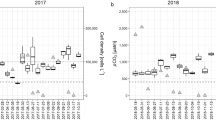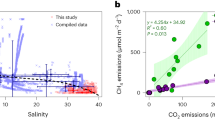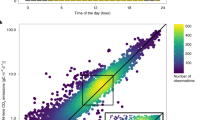Abstract
Streams and rivers are an important source of CO2 emissions1. One important control of these emissions is the metabolic balance between photosynthesis, which converts CO2 to organic carbon, and respiration, which converts organic carbon into CO2 (refs 2,3). Carbon emissions from rivers could increase with warming, independently of organic carbon inputs, because the apparent activation energy is predicted to be higher for respiration than photosynthesis4,5. However, physiological CO2-concentrating mechanisms may prevent the increase in photorespiration, limiting photosynthesis with warming6. Here we report the thermal response of aquatic photosynthesis from streams located in geothermal areas of North America, Iceland and Kamchatka with water temperatures ranging between 4 and 70 °C. Based on a thermodynamic theory of enzyme kinetics, we show that the apparent activation energy of aquatic ecosystem photosynthesis is approximately 0.57 electron volts (eV) for temperatures ranging from 4 to 45 °C, which is similar to that of respiration4,5,7,8,9. This result and a global synthesis of 222 streams suggest that warming will not create increased stream and river CO2 emissions from a warming-induced imbalance between photosynthesis and respiration. However, temperature could affect annual CO2 emissions from streams if ecosystem respiration is independent of gross primary production, and may be amplified by increasing organic carbon supply.
This is a preview of subscription content, access via your institution
Access options
Subscribe to this journal
Receive 12 print issues and online access
$259.00 per year
only $21.58 per issue
Buy this article
- Purchase on Springer Link
- Instant access to full article PDF
Prices may be subject to local taxes which are calculated during checkout



Similar content being viewed by others
References
Raymond, P. A. et al. Global carbon dioxide emissions from inland waters. Nature 503, 355–359 (2013).
Battin, T. J. et al. Biophysical controls on organic carbon fluxes in fluvial networks. Nat. Geosci. 1, 95–100 (2008).
Hotchkiss, E. R. et al. Sources of and processes controlling CO2 emissions change with the size of streams and rivers. Nat. Geosci. 8, 696–699 (2015).
Yvon-Durocher, G., Jones, J. I., Trimmer, M., Woodward, G. & Montoya, J. M. Warming alters the metabolic balance of ecosystems. Phil. Trans. R. Soc. B 365, 2117–2126 (2010).
Yvon-Durocher, G. et al. Reconciling the temperature dependence of respiration across timescales and ecosystem types. Nature 487, 472–476 (2012).
Demars, B. O. L., Thompson, J. & Manson, J. R. Stream metabolism and the open diel oxygen method: principles, practice, and perspectives. Limnol. Oceanogr. Methods 13, 356–374 (2015).
Sand-Jensen, K., Pedersen, N. L. & Sondergaard, M. Bacterial metabolism in small temperate streams under contemporary and future climates. Freshwat. Biol. 52, 2340–2353 (2007).
Acuña, V., Wolf, A., Uehlinger, U. & Tockner, K. Temperature dependence of stream benthic respiration in an Alpine river network under global warming. Freshwat. Biol. 53, 2076–2088 (2008).
Perkins, D. M. et al. Consistent temperature dependence of respiration across ecosystems contrasting in thermal history. Glob. Change Biol. 18, 1300–1311 (2012).
Allen, A. P., Gillooly, J. F. & Brown, J. H. Linking the global carbon cycle to individual metabolism. Funct. Ecol. 19, 202–213 (2005).
Lin, M. T., Occhialini, A., Andralojc, P. J., Parry, M. A. J. & Hanson, M. R. A faster Rubisco with potential to increase photosynthesis in crops. Nature 513, 547–550 (2014).
Raven, J. A. & Geider, R. J. Temperature and algal growth. New Phytol. 110, 441–461 (1988).
Galmés, J., Kapralov, M. V., Copolovici, L. O., Hermida-Carrera, C. & Niinemets, Ü. Temperature responses of the Rubisco maximum carboxylase activity across domains of life: phylogenetic signals, trade-offs, and importance for carbon gain. Photosynth. Res. 123, 183–201 (2015).
Tcherkez, G. G. B., Farquhar, G. D. & Andrews, T. J. Despite slow catalysis and confused substrate specificity, all ribulose bisphosphate carboxylases may be nearly perfectly optimized. Proc. Natl Acad. Sci. USA 103, 7246–7251 (2006).
Demars, B. O. L. et al. Temperature and the metabolic balance of streams. Freshwat. Biol. 56, 1106–1121 (2011).
Falkowski, P. G. & Raven, J. A. Aquatic Photosynthesis 2nd edn (Princeton Univ. Press, 2007).
Raven, J. A., Cockell, C. S. & De La Rocha, C. L. The evolution of inorganic carbon concentrating mechanisms in photosynthesis. Phil. Trans. R. Soc. B 363, 2641–2650 (2008).
Bernacchi, C. J. et al. Modelling C3 photosynthesis from the chloroplast to the ecosystem. Plant Cell Environ. 36, 1641–1657 (2013).
Raven, J. A. & Beardall, J. CO2 concentrating mechanisms and environmental change. Aquat. Bot. 118, 24–37 (2014).
Schoolfield, R. M., Sharpe, P. J. H. & Magnuson, C. E. Non-linear regression of biological temperature dependent rate models based on absolute reaction rate theory. J. Theor. Biol. 88, 719–731 (1981).
Pawar, S., Dell, A. I. & Savage, V. M. in Aquatic Functional Biodiversity. An Ecological and Evolutionary Perspective (eds Belgrano, A., Woodward, G. & Jacob, U.) Ch. 1, 3–36 (Academic, 2015).
Kerkhoff, A. J., Enquist, B. J., Elser, J. J. & Fagan, W. F. Plant allometry, stoichiometry and the temperature-dependence of primary productivity. Glob. Ecol. Biogeogr. 14, 585–598 (2005).
Michaletz, S. T., Cheng, D., Kerkhoff, A. J. & Enquist, B. J. Convergence of terrestrial plant production across global climate gradients. Nature 512, 39–44 (2014).
Welter, J. R. et al. Does N2 fixation amplify the temperature dependence of ecosystem metabolism? Ecology 96, 603–610 (2015).
Hall, R. O. & Beaulieu, J. J. Estimating autotrophic respiration in streams using daily metabolism data. Freshwat. Sci. 32, 507–516 (2013).
Bernot, M. J. Inter-regional comparison of land-use effects on stream metabolism. Freshwat. Biol. 55, 1874–1890 (2010).
Davidson, T. A. et al. Eutrophication effects on greenhouse gas fluxes from shallow-lake mesocosms override those of climate warming. Glob. Change Biol. 21, 4449–4463 (2015).
Karhu, K. et al. Temperature sensitivity of soil respiration rates enhanced by microbial community response. Nature 513, 81–84 (2014).
Padfield, D., Yvon-Durocher, G., Buckling, A., Jennings, S. & Yvon-Durocher, G. Rapid evolution of metabolic traits explains thermal adaptation in phytoplankton. Ecol. Lett. 19, 133–142 (2016).
Dewar, R. C., Medlyn, B. E. & McMurtrie, R. E. Acclimation of the respiration photosynthesis ratio to temperature: insights from a model. Glob. Change Biol. 5, 615–622 (1999).
Cross, W. F., Hood, J. M., Benstead, J. P., Huryn, A. D. & Nelson, D. Interactions between temperature and nutrients across levels of ecological organization. Glob. Change Biol. 21, 1025–1040 (2015).
López-Urrutia, A., San Martin, E., Harris, R. P. & Irigoien, X. Scaling the metabolic balance of the oceans. Proc. Natl Acad. Sci. USA 103, 8739–8744 (2006).
Lapierre, J.-F., Guillemette, F., Berggren, M. & del Giorgio, P. A. Increases in terrestrially derived carbon stimulate organic carbon processing and CO2 emissions in boreal aquatic ecosystems. Nat. Commun. 4, 2972 (2013).
Lenn, R. C. Primary Productivity of a Thermal Spring MSc thesis, Univ. California Davis (1966).
Brock, T. D. Relationship between standing crop and primary productivity along a hot spring thermal gradient. Ecology 48, 566–571 (1967).
Stockner, J. G. Algal growth and primary productivity in a thermal stream. J. Fish Res. Board Can. 25, 2037–2058 (1968).
Revsbech, N. P. & Ward, D. M. Microelectrode studies of interstitial water chemistry and photosynthetic activity in a hot-spring microbial mat. Appl. Environ. Microbiol. 48, 270–275 (1984).
Jorgensen, B. B. & Nelson, D. C. Bacterial zonation, photosynthesis, and spectral light distribution in hot spring microbial mats of Iceland. Microb. Ecol. 16, 133–147 (1988).
Iwata, T. et al. Metabolic balance of streams draining urban and agricultural watersheds in central Japan. Limnology 8, 243–250 (2007).
Marti, E. et al. Variation in stream C, N and P uptake along an altitudinal gradient: a space-for-time analogue to assess potential impacts of climate change. Hydrol. Res. 40, 123–137 (2009).
Masese, F. O. Dynamics in Organic Matter Processing, Ecosystem Metabolism and Trophic Sources for Consumers in the Mara River, Kenya (CRC Press/Balkema, 2015).
Bott, T. L. et al. Ecosystem metabolism in streams of the Catskill Mountains (Delaware and Hudson River watersheds) and Lower Hudson Valley. J. North Am. Benthol. Soc. 25, 1018–1044 (2006).
Riley, A. J. & Dodds, W. K. Whole-stream metabolism: strategies for measuring and modeling diel trends of dissolved oxygen. Freshwat. Sci. 32, 56–69 (2013).
Edwards, R. W. & Owens, M. The effect of plants on river conditions. IV. The oxygen balance of a chalk stream. J. Ecol. 50, 207–220 (1962).
Odum, H. T. Primary production measurements in eleven Florida springs and a marine turtle-grass community. Limnol. Oceanogr. 2, 85–97 (1957).
Fellows, C. S., Valett, H. M. & Dahm, C. N. Whole-stream metabolism in two montane streams: contribution of the hyporheic zone. Limnol. Oceanogr. 46, 523–531 (2001).
Fellows, C. S., Valett, H. M., Dahm, C. N., Mulholland, P. J. & Thomas, S. A. Coupling nutrient uptake and energy flow in headwater streams. Ecosystems 9, 788–804 (2006).
Gücker, B., Boechat, I. G. & Giani, A. Impacts of agricultural land use on ecosystem structure and whole-stream metabolism of tropical Cerrado streams. Freshwat. Biol. 54, 2069–2085 (2009).
Von Schiller, D. et al. Influence of land use on stream ecosystem function in a Mediterranean catchment. Freshwat. Biol. 53, 2600–2612 (2008).
Dawson, J. J. C., Billett, M. F. & Hope, D. Diurnal variations in the carbon chemistry of two acidic peatland streams in north-east Scotland. Freshwat. Biol. 46, 1309–1322 (2001).
Stutter, M. I., Demars, B. O. L. & Langan, S. J. River phosphorus cycling: separating biotic and abiotic uptake during short-term changes in sewage effluent loading. Water Res. 44, 4425–4436 (2010).
Wilcock, R. J. et al. Characterisation of lowland streams using a single-station diurnal curve analysis model with continuous monitoring data for dissolved oxygen and temperature. NZ J. Mar. Freshwat. Res. 32, 67–79 (1998).
Chapra, S. C. & Di Toro, D. M. Delta method for estimating primary production, respiration, and reaeration in streams. J. Environ. Eng.-ASCE 117, 640–655 (1991).
Sharpe, P. J. H. & DeMichele, D. W. Reaction kinetics of poikilotherm development. J. Theor. Biol. 64, 649–670 (1977).
Young, J. N., Goldman, J. A. L., Kranz, S. A., Tortell, P. D. & Morel, F. M. M. Slow carboxylation of Rubisco constrains the rate of carbon fixation during Antarctic phytoplankton blooms. New Phytol. 205, 172–181 (2015).
R Core Team R: A Language and Environment for Statistical Computing (R Foundation for Statistical Computing, 2015); http://www.R-project.org
Benjamini, Y. & Hochberg, Y. Controlling the false discovery rate: a practical and powerful approach to multiple testing. J. R. Stat. Soc. B 57, 289–300 (1995).
Winter, B. Linear models and linear mixed effects models in R with linguistic applications. Preprint at http://arXiv.org/abs/1308.5499 (2013).
Bolker, B. M. et al. Generalized linear mixed models: a practical guide for ecology and evolution. Trends Ecol. Evol. 24, 127–135 (2009).
Bates, D. et al. Package ‘lme4’ Linear Mixed-Effects Models using ‘Eigen’ and S4. R package version 1.1-10. (R Foundation for Statistical Computing, 2015); https://CRAN.R-project.org/package=lme4
Kuznetsova, A., Brockhoff, P. B. & Christensen, R. H. B. lmerTest: Tests in Linear Mixed Effects Models. R package version 2.0-29. (R Foundation for Statistical Computing, 2015); http://CRAN.R-project.org/package=lmerTest
Barton, K. Package ‘MuMIn’. R package version 1.15.6. (R Foundation for Statistical Computing, 2016); https://CRAN.R-project.org/package=MuMIn
Johnson, P. C. D. Extension of Nakagawa Schielzeth’s R-GLMM(2) to random slopes models. Methods Ecol. Evol. 5, 944–946 (2014).
Acknowledgements
We wish to thank the park rangers for permission to work in Iceland and Kamchatka; B. Marteau, R. Magnúsdóttir, D. Árnadóttir, Yu. Bespalaya, O. Usacheva, A. Kondakov and I. Bolotov for help with fieldwork; and Y. Cook, H. Watson, L. Johnson, S. McIntyre for processing water chemical analyses. B.O.L.D. and T.E.F. were funded by the Scottish Government Rural and Environmental Science and Analytical Services (RESAS). J.S.Ó., G.M.G. and B.O.L.D. were funded by the Icelandic National Power Company’s Energy and Environmental Fund. J.R.M. was funded by Stockton University. N.F. and the travel to Kamchatka were partly funded by AU IDEAS. J.M.H. was supported by the Icelandic Research Fund (i. Rannsóknasjóður) 141840-051 during manuscript preparation. J.J.D.T. was funded by NERC grant NE/J011967/1. Comments by S. Maberly and J. Kemp improved the manuscript.
Author information
Authors and Affiliations
Contributions
B.O.L.D., G.M.G., J.S.Ó., J.R.M. and N.F. designed the field study. B.O.L.D. analysed the data and wrote the manuscript. B.O.L.D. and J.J.D.T. assembled the global synthesis and provided additional unpublished data. All authors contributed to at least one field expedition and commented on the manuscript.
Corresponding author
Ethics declarations
Competing interests
The authors declare no competing financial interests.
Supplementary information
Supplementary Information
Supplementary Information (PDF 1404 kb)
Supplementary Information
Supplementary Information (XLSX 65 kb)
Supplementary Information
Supplementary Information (XLSX 31 kb)
Rights and permissions
About this article
Cite this article
Demars, B., Gíslason, G., Ólafsson, J. et al. Impact of warming on CO2 emissions from streams countered by aquatic photosynthesis. Nature Geosci 9, 758–761 (2016). https://doi.org/10.1038/ngeo2807
Received:
Accepted:
Published:
Issue Date:
DOI: https://doi.org/10.1038/ngeo2807
This article is cited by
-
Metabolic balance in the euphotic layer of Lake Sagami, Japan
Limnology (2024)
-
Flow is more Important than Temperature in Driving Patterns of Organic Matter Storage and Stoichiometry in Stream Ecosystems
Ecosystems (2021)
-
Carbon dioxide fluxes increase from day to night across European streams
Communications Earth & Environment (2021)
-
Global lake thermal regions shift under climate change
Nature Communications (2020)
-
A simplified approach to detect a significant carbon dioxide reduction by phytoplankton in lakes and rivers on a regional and global scale
The Science of Nature (2020)



